
My dad would have been pleased...
When graduate students learn how to process archives, we all benefit.
Coming Soon! New Library Website
Turned Texts: Alterations by Artists, Readers & Nature
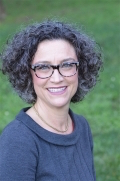 Starting a new year, either calendar or academic, gives us an excellent opportunity to stop and reflect on where we’ve been and where we’re going. The University Library has always been a center of the university community, and with our ongoing efforts to update it for the 21st century, it will continue to be a focus both of change and memory.
Starting a new year, either calendar or academic, gives us an excellent opportunity to stop and reflect on where we’ve been and where we’re going. The University Library has always been a center of the university community, and with our ongoing efforts to update it for the 21st century, it will continue to be a focus both of change and memory.
I’m very excited about the huge step forward we’re taking this fall with the opening of the Active Learning Classroom, or ALC. The ALC continues UCSC’s famous tradition of innovative approaches to teaching and learning, and it also revitalizes the Science & Engineering Library as a place that offers students and faculty a dynamic learning space and source of community.
This sense of fellowship is essential for student retention. Recent years have seen a considerable change in the student body, with close to 40% of incoming students being first-generation college students and around 70% being members of a traditionally underrepresented group (first-generation, women in science, low income, underrepresented minority, etc.) As a result, public community spaces like the library are playing an even more essential role in reducing student attrition and maintaining a diverse student body.
We are also working hard at the University Library to support collaborative learning while honoring our history. Many of our group study rooms are named after prominent individuals, including the Noel and Laurie King room, named after one of the founding professors of UCSC and his wife, a bestselling mystery writer. The adjacent room is named after Professor Narinder Kapany, a friend of Noel’s, who requested that he be placed next door because “it’s a good neighborhood.” These kinds of lasting relationships are crucial to the history of our campus as well as to the current student body, who will form their own lifelong friendships as they learn together in these rooms.
Finally, I want to highlight our Center for Archival Research and Training, or CART, a cutting-edge program that demonstrates how the University Library faces forward even when it is examining the past. CART accepts graduate students from all disciplines and gives them first-hand experience processing and interpreting archival materials. For example, students from the Arts Division have worked on the Grateful Dead materials, and Social Science students have helped process the archives of the Lick Observatory, and the Ken Norris papers. We are proud to offer this interdisciplinary archival studies program and offer our students a valuable experience while making our materials more accessible to scholars across the world.
I hope you will enjoy learning more about these wonderful aspects of our library’s past and future. You are also an essential part of our community, and we value your support of our initiatives as we move forward into the new year and beyond.
Best,
Elizabeth Cowell
Richard L. Press University Librarian
Presidential Chair
The brand new Active Learning Classroom (ALC) in the Science & Engineering Library is an excellent example of how UCSC is moving into the 21st century. Funded by a grant from the Howard Hughes Medical Institute, the ALC is a “98-seat, technology-rich classroom that will support innovative approaches to teaching STEM curricula that focus on active learning rather than traditional lectures.”
The first thing one notices ab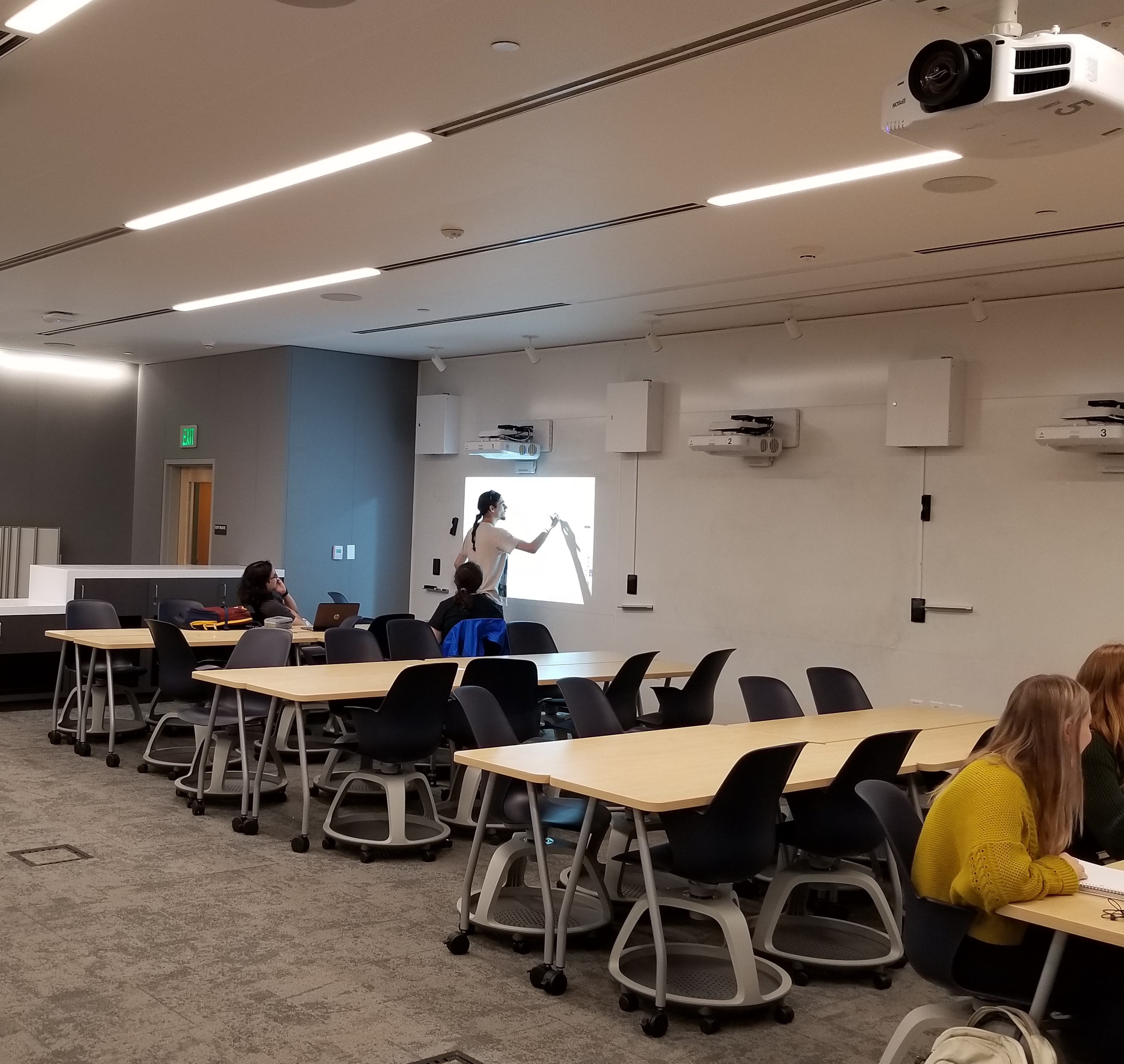 out the ALC is its space-age seats and desks. The chairs have wheeled circular bases, and the tables are small and modular, allowing for multiple different learning configurations. According to Dr. Colin West, a physics postdoctoral fellow who has been one of the first to teach in this new space, the desks and chairs can be rearranged in different ways to promote active, dynamic learning. They can be aligned with the walls, in groups, or gathered into larger tables—and in a few weeks, Dr. West is planning to use the tables themselves as props to demonstrate an exercise in buoyancy.
out the ALC is its space-age seats and desks. The chairs have wheeled circular bases, and the tables are small and modular, allowing for multiple different learning configurations. According to Dr. Colin West, a physics postdoctoral fellow who has been one of the first to teach in this new space, the desks and chairs can be rearranged in different ways to promote active, dynamic learning. They can be aligned with the walls, in groups, or gathered into larger tables—and in a few weeks, Dr. West is planning to use the tables themselves as props to demonstrate an exercise in buoyancy.
The walls of the ALC appear to be normal, but they are what makes the space truly special. Around the perimeter of the classroom, there are several short-throw overhead projectors, along with five larger projectors in the center of the classroom. Each of these can be linked either to the instructor’s computer, showing the same image or slide across the classroom, or they can be run individually by different computers (including a student’s own).
Each short-throw projector casts its image not just onto a blank screen, but rather onto a wall that is a combination of whiteboard and touchscreen. The students can use fingers or a stylus to mark up the projection directly on the board beneath and/or manipulate the images themselves, fostering creativity and collaboration around the classroom. They can also save their collaborative work digitally.
The sound system in the ALC is similarly state of the art. According to Dr. West, “the mic is expertly calibrated so that the whole room can hear me even when the students are talking amongst themselves, but it is not so loud that it is overbearing or distracting for me as the lecturer.” This feature allows the instructor to call the students back to order or point out good work where credit is due.
According to Dr. West, the ALC works particularly well for science learning because it so closely simulates the feeling of a lab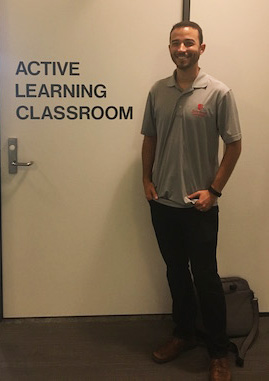 oratory. Furthermore, the tangible nature of the classroom is particularly well-suited to the tangible nature of the hard sciences. While it often looks like chaos when his students are learning in groups, it is a “structured, managed chaos” that easily transitions between free-form and structured learning thanks to the nature of the classroom.
oratory. Furthermore, the tangible nature of the classroom is particularly well-suited to the tangible nature of the hard sciences. While it often looks like chaos when his students are learning in groups, it is a “structured, managed chaos” that easily transitions between free-form and structured learning thanks to the nature of the classroom.
Currently, Dr. West is teaching Physics 7A, an alternative to introductory physics aimed at biology majors. It is focused on material particularly relevant to biologists and is aimed at a more active style of learning that is ideally suited for the ALC. The setting makes teaching both smoother and more enjoyable, which for Professor West came as a relief. He says that the ALC bears no resemblance to the physics classrooms he grew up in, which at first felt scary, but “is pretty brilliant.” While he has been wary of gimmicky promises he is heard in the past about how technology can change teaching, this classroom, he says, is the real thing.
The ALC is just one way that the University Library is leveraging private support toward creating state of the art learning environments and encouraging active learning and collaboration in undergraduate teaching.
My dad would have been pleased...
On the third floor of McHenry Library is the Noel Q. and Laurie King group study room. Its tall windows look out on towe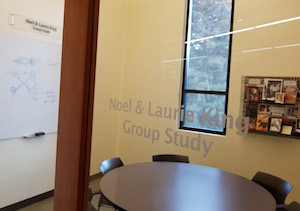 ring redwood trees. When empty, it is quiet and unassuming, shadowy and cool. When in use, it comes alive as a place of collaborative study and learning that reflects the educational philosophy of UCSC, and of my parents, the donors for whom it is named.
ring redwood trees. When empty, it is quiet and unassuming, shadowy and cool. When in use, it comes alive as a place of collaborative study and learning that reflects the educational philosophy of UCSC, and of my parents, the donors for whom it is named.
My father, Noel Q. King, first saw those trees fifty years ago. He had been recruited to help the fledgling university form a Religious Studies department, just as he had done twice already in post-colonial Africa: first at the University of Ghana, and later at Uganda’s Makerere University. At both places, my dad integrated the study of Comparative Religions with the university’s existing programs and its growth as a whole, then turned the management of the new department over to the university itself. It was at this point in his career that my dad met Philip Bell, the founding provost of Merrill College, who had been tasked with setting up a Third World Studies college at an innovative new University of California campus in Santa Cruz. The two men agreed that a person could not study the world without studying its religions.
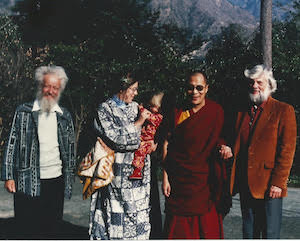 My father’s background made him uniquely suited for the job. Born in India, he attended English-style boarding school for most of his childhood, combining a traditional expat Christian upbringing with life among Hindus and Muslims. He went to England after the War, where he was ordained into the Anglican Church and took university degrees in early Christian history. When he and his first wife and family went to Africa, he studied African Traditional Religion and the coming together of Christianity and Islam. Being a man whose entire life was at the meeting-point of cultures, he was more likely to see the bridge than the chasm beneath it.
My father’s background made him uniquely suited for the job. Born in India, he attended English-style boarding school for most of his childhood, combining a traditional expat Christian upbringing with life among Hindus and Muslims. He went to England after the War, where he was ordained into the Anglican Church and took university degrees in early Christian history. When he and his first wife and family went to Africa, he studied African Traditional Religion and the coming together of Christianity and Islam. Being a man whose entire life was at the meeting-point of cultures, he was more likely to see the bridge than the chasm beneath it.
My mom started at UCSC in 1973, entering the new Religious Studies department. Most of its classes were linked with other departments, reflecting the dialectical and interdisciplinary nature of the degree my dad had helped to create—for example, a class on cosmology offered through the astronomy department, or a Stevenson College course on the Sikh farmer-warrior that collaborated with the Farm. Independent work was also highly encouraged, such as her quarter-long project on alchemy.
Laurie later used this project and many of her other studies to inform her fiction writing. The inspiration and scholarship for her novel about a holy fool came from a class taught by my British godfather, Donald Nichol, and her work in women’s studies led to multiple books exploring the nature of women in religion. Throughout her career as a writer, she has continued to explore religion as a living, breathing thing.
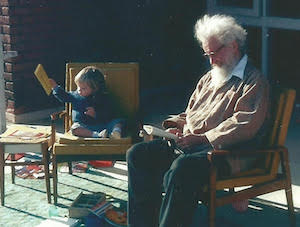 Keeping both religious exploration and my father’s memory alive on campus today is why we started the Noel Q. King Memorial Lecture series. Our most successful effort to date was in 2013 when we brought three other mystery authors to Santa Cruz to discuss how they use religion in their fiction. Along with Laurie, there was a medievalist, another who writes about a woman priest, and one who explores the role of women and religion in modern Saudi Arabia. This conversation was very much in the vein of my father’s legacy and the founding spirit of UCSC. You can watch the video of this conversation here.
Keeping both religious exploration and my father’s memory alive on campus today is why we started the Noel Q. King Memorial Lecture series. Our most successful effort to date was in 2013 when we brought three other mystery authors to Santa Cruz to discuss how they use religion in their fiction. Along with Laurie, there was a medievalist, another who writes about a woman priest, and one who explores the role of women and religion in modern Saudi Arabia. This conversation was very much in the vein of my father’s legacy and the founding spirit of UCSC. You can watch the video of this conversation here.
This same spirit is physically embodied in the reading room named for my parents. When the university was formed, it was intentionally modeled after the disparate nature of the Oxbridge system. At its founding, each college was its own world, with its own library, café, classrooms, and administration. McHenry library formed the unifying center of university life—the place where both professors and freshmen went to get books, where the Chancellor’s office was housed, where people met to discuss and collaborate and learn.
Today, although the colleges have become more integrated, the library has become even more of a center for the University. With the addition of Wi-Fi and a café, it has become a vibrant center of learning and discussion, with the study rooms providing a place where people can come together to share ideas and work collaboratively.
As my mom says, my dad would have been very pleased to know that bits and pieces of his life—some of his African artifacts, his books, and of course, his picture—now look down over those same redwoods and a room full of undergraduates doing what they do best: discussing, collaborating, arguing, growing, and learning.
Written by Zoe Quinton, daughter of Noel and Laurie King
When graduate students learn how to process archives, we all benefit.
For more than fifty years, McHenry Library has been at the forefront of cutting-edge research, due in large part to its world-class archives and special collections. In 2014, Elisabeth Remak-Honnef founded the Center for Archival Research and Training or CART. This innovative program integrates primary source research into the graduate experience on campus while expediting the processing and cataloging of archival collections housed in McHenry Library. The program is doubly beneficial - graduate students get paid practical experience in archival processing, and the archives are made more discoverable and accessible for research.
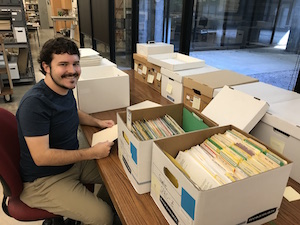 During their fellowships, CART scholars complete a total of 100 hours of applied training in archival processing, supervised by Archivist Alix Norton. The fellows assist at every stage of the processing, from assessing the contents and addressing immediate preservation concerns, to writing a biography of the donating person or organization and creating a finding aid to help researchers discover the materials they need. These finding aids are then placed online in the Online Archive of California, where they can be accessed by scholars around the world.
During their fellowships, CART scholars complete a total of 100 hours of applied training in archival processing, supervised by Archivist Alix Norton. The fellows assist at every stage of the processing, from assessing the contents and addressing immediate preservation concerns, to writing a biography of the donating person or organization and creating a finding aid to help researchers discover the materials they need. These finding aids are then placed online in the Online Archive of California, where they can be accessed by scholars around the world.
CART has been a great success during its first three years. It has expanded from three fellows to five, and more applicants compete for a spot each year. Norton believes this popularity is due to the unique opportunities the program affords in applied archival research and curatorial training, as well as high praise offered by former CART fellows.
One of these former fellows, Alessia Cecchet, is a Ph.D. student in Film & Digital Media. During her fellowship in the summer of 2017, she helped to process the Grateful Dead collection, which helped her to see that history is made up of a “multiplicity of voices.” According to Cecchet, her favorite part of the archival work was the unexpected stories that would “pop up” every day. For example, she found brochures for the Grateful Dead’s induction into the Rock and Roll Hall of Fame, which were shaped like a mask of Jerry Garcia. She said these experiences reinforce her existing passion for archives, the stories they tell and how they are put together.
After completing their training, CART fellows present their work at the annual Graduate Research Symposium during Spring quarter and curate an exhibit of their own that features materials from the collections they processed. These exhibits are displayed on the third floor of McHenry Library outside of the Special Collections Reading Room and are accompanied by a digital companion exhibit that remains online after the fellowships are complete. (Click here to view past exhibits.)
Creating an exhibit allows the graduate students to look at the archives they’ve worked with from a different angle: they can explain and interpret the archives based on the questions that they want to explore instead of only presenting them objectively for other scholars to interpret. Since there is often more than one fellow working on any given collection, many exhibits are collaborative or interdisciplinary. Fellows also collaborate with library staff in producing their exhibits, including Rachel Deblinger, Director of the Digital Scholarship Commons, and Jessica Pigza, Special Collections Outreach & Exhibits Librarian.
In the future, Alix Norton says she hopes to continue expanding the CART program, creating opportunities for even more students to gain first-hand archival experiences. Undergraduates, for example, rarely have the opportunity to conduct primary source research, but the graduate CART fellows
have increasingly been using their archival experience in their research and their teaching with undergraduate students. Students from various departments and backgrounds provide invaluable experience and perspective to the program, so Alix hopes to create new collaborations that will attract students from a broader spectrum of studies.
Regardless of discipline, the CART program is highly beneficial to both its fellows and the library. The fellows gain invaluable experience and a stipend, while archival collections are processed and made accessible at a faster rate. The CART fellows also gain practical work experience and get a glimpse of alternate career path—something not on the tenure track but still in the realm of academia. For many graduate students, particularly in the humanities, this larger perspective is invaluable and can open many doors. Above all, these students form a lasting relationship with each other, with the archives they process, and with the library.
Coming Soon! New Library Website
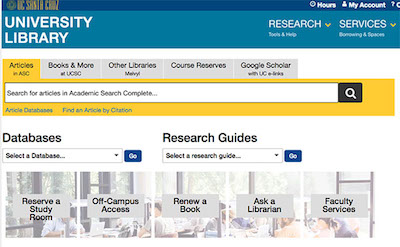 Starting in January 2018, the library website will have a brand new look and feel. Check out the live preview site and let us know what you think! The new site has been reorganized to require fewer clicks and to highlight the most common research tools and services. For example, students can see our hours and reserve a group study room right from the home page without navigating through the menus. Faculty can see a menu of services of greatest interest to them such as recommending a purchase for the library’s collection.
Starting in January 2018, the library website will have a brand new look and feel. Check out the live preview site and let us know what you think! The new site has been reorganized to require fewer clicks and to highlight the most common research tools and services. For example, students can see our hours and reserve a group study room right from the home page without navigating through the menus. Faculty can see a menu of services of greatest interest to them such as recommending a purchase for the library’s collection.
The redesigned site is a product of a year-long process to understand the needs of our users and their research goals. The library web team conducted focus groups with library staff, undergraduate and graduate students, and with faculty. We’ve combed through the analytics for the current site to see just how our users are navigating the thousands of pages on the library websites. We will gather feedback from users and put the new site through lots of tests to make sure we’re ready to launch in January. The preview site will be linked on the current home page for the rest of the year, so check it out and give us your thoughts!
Turned Texts: Alterations by Artists, Readers & Nature
Opening December 14, 2017, through April 29, 2018
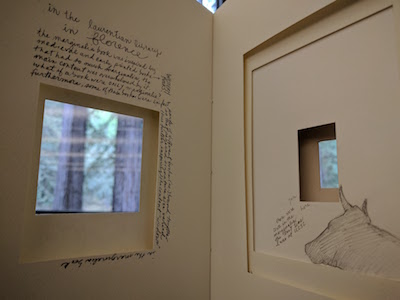 Turned Texts presents a selection of materials from the Library’s Special Collections & Archives—printed and handwritten, historical and modern—alongside award-winning book arts projects created by students of Porter College’s Core Course, in an exploration of the unique histories and creative inspirations held within altered texts, annotated maps, and artists’ books.
Turned Texts presents a selection of materials from the Library’s Special Collections & Archives—printed and handwritten, historical and modern—alongside award-winning book arts projects created by students of Porter College’s Core Course, in an exploration of the unique histories and creative inspirations held within altered texts, annotated maps, and artists’ books.
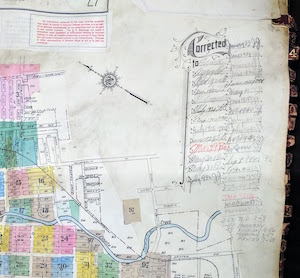 We’re transformed every day by documents and historical information that inspire new knowledge. These texts themselves are, in turn, changed through their encounters with both human and nonhuman actors. A book’s margins may reveal stories about how a reader responded to a passage, or how one owner reused an old volume for an entirely new purpose. A text might be reshaped wholly by an artist who incorporates it into new work. Maps can bear the marks of correction applied to keep pace with the places they depict. Even plants and insects can irrevocably alter the pages of a volume. Turned Texts meditates on these changes through historical and new works.
We’re transformed every day by documents and historical information that inspire new knowledge. These texts themselves are, in turn, changed through their encounters with both human and nonhuman actors. A book’s margins may reveal stories about how a reader responded to a passage, or how one owner reused an old volume for an entirely new purpose. A text might be reshaped wholly by an artist who incorporates it into new work. Maps can bear the marks of correction applied to keep pace with the places they depict. Even plants and insects can irrevocably alter the pages of a volume. Turned Texts meditates on these changes through historical and new works.
The Library was proud to collaborate with Porter College on its Fall 2017 Core Course in Composition, Creative Inquiry, and the Arts. All students in this class (more than 400 in total) visited Special Collections & Archives for an immersive introduction to the nature and function of artists’ books, in anticipation of creating their own altered-book artwork. Selected creative work from this class will be featured in Turned Texts.
Congratulations and best wishes to our 2017 Library retirees! Thank you for your service to the University Library and for improving the learning and wellbeing of our students at UC Santa Cruz!
Thank you for providing over 150 years of service!
• Elisabeth Remak-Honnef
• Janet Young
• Josephine Stovall
• Terry Haugen
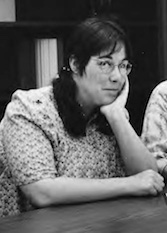
• Maureen Carey
Contributors: Elizabeth Cowell, Zoe Quinton, Susan Chesley Perry, Jessica Pigza and Linda Hunt
Production: Linda Hunt
Copyediting: Greg Careaga
Photography: Linda Hunt, Zoe Quinton, Jessica Pigza and Alix Norton
Other Images credits:
My dad would have been pleased...
Middle: L to R: Noel King, Laurie King, Zoe King, Dalai Lama, Ken Orrett taken in 1982 in India.
Bottom: Zoe Quiton and her dad, Noel King.
When graduate students learn how to process archives, we all benefit.
Top: Jay Arms, 2017-2018 CART fellow, processing the organizational records of Other Minds
Middle: Alessia Cecchet, 2017-2018 CART fellow, with a piece from the Grateful Dead Archives
Bottom: The 2016-2017 CART exhibit on display in McHenry Library
Turned Texts: Alterations by Artists, Readers & Nature
Top: #51 Marginalia Book from A year in books: 52 weeks: 52 books by
Lyall Harris (2013)
Bottom: Insurance maps of San Jose, California by Sanborn Map Company (1915)


 Santa Cruz, CA
Santa Cruz, CA



